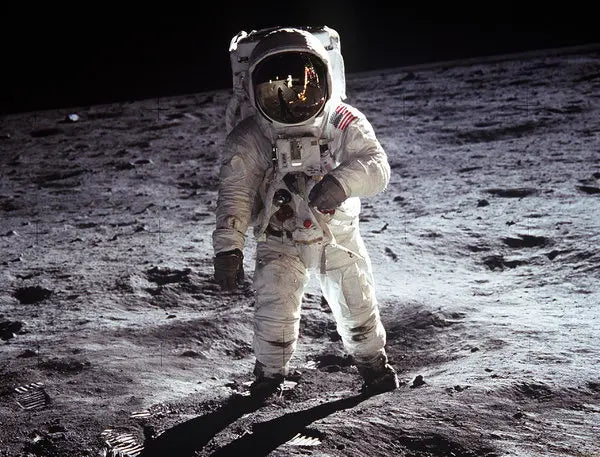We’ve all heard the tales of NASA spending millions of dollars to develop a pen capable of writing in zero gravity, only to find out that the Russians had already got round the issue … by using a pencil. Perhaps unsurprisingly, the story isn’t strictly true; the US had already ruled out the use of pencils due to the risk of graphite shards short circuiting delicate electrical systems, hence the small fortune poured into developing a pricey alternative. All that to say, every piece of equipment involved in spaceflight needs careful consideration to ensure that it’s 100% up to the task, and astronaut timepieces are certainly no exception. This article takes a look at the iconic watches used across a variety of historic space missions, as well as digging into some of specs that made them particularly suited for use in such demanding applications.

The first watch in space*
The story of the first watch worn on a human spaceflight is one that’s shrouded in its fair share of mystery. What we know for sure is that Yuri Gagarin wore a timepiece during humanity’s first ever voyage beyond the Earth’s atmosphere. However, what we don’t know is exactly what brand and model the watch was, and we can’t ask Gagarin directly as he died tragically in a training exercise just a few years after the historic feat. One thing’s for sure though, it must have been a Soviet-made watch as Stalin had previously directed the USSR to establish its own national watchmaking industry specifically to supply the Russian military. The leading theory is that Gagarin used the Sturmanskie watch he was awarded at his graduation from Chkalov Air Force Pilot School, with the brand strongly championing the story and claiming the timepiece in question to be a Type 2 model. However, deeper digging reveals that the company actually stopped issuing this model to newly qualified pilots in 1953, four years before Gagarin himself graduated. The plot thickens…

* This is probably a good time to admit that while Gagarin’s watch was the first to be used on a manned space mission, it wasn’t actually the first watch in space. That title belongs to a Pobeda 34-k strapped to a Russian dog that was sent into orbit just a month earlier.
America playing catch up
The next notable entry into the list is the timepiece worn by John Glenn, the first American to enter Earth orbit. Brace yourselves though, this one’s going to feel like a bit of a letdown to chronograph enthusiasts; Glenn opted for a Heuer 2915A stopwatch rather unceremoniously strapped to his arm with an elastic band. Fortunately, Scott Carpenter made up for this in style a year later by wearing a much classier timepiece – a Breitling Cosmonaute Navitimer – during his repeat of the historic orbital flight. The watch featured a Venus 178 hand-wound calibre specially converted for Breitling, as well as a custom wider bezel to afford astronauts seamless use of the slide rule when wearing thick gloves. Carpenter also requested it to sport a 24-hr dial – rather than the standard 12-hr affair – in order to help him tell the difference between AM and PM in an environment where the sun rises and sets in quick succession. Rather ironically, the watch successfully survived the extremes of space only to succumb to water damage after splashdown in the Atlantic Ocean. Despite this mishap, the use of the Navitimer truly set the tone for America’s future space missions, with NASA choosing to rely on Swiss engineering from here on out – namely OMEGA, Breitling, Accutron, Longines, Glycine and the occasional Rolex.

First spacewalk
At this point, it’s prudent to emphasise that the watches mentioned thus far were solely used within the relative safety of a pressurised spacecraft, but it was only a matter of time before they’d need to be able to withstand the ultimate test – the freezing vacuum of space. That day came on 18th March 1965 when cosmonaut Alexi Leonov completed history’s first ever spacewalk, leaving the comfort of the Vostok 2 capsule and stepping into the unknowns of Outer Space. Fortunately, details of this cosmonaut’s timepiece aren’t shrouded mystery like Gagarin’s. He wore a white-faced Poljet Strela: a mechanical two register chronograph with a 45-minute totaliser and continuously running second hand. Even though the spacewalk only lasted for just over 12 minutes, it must have felt like an eternity for Leonov as the differential pressure caused his suit to expand to such an extent that he couldn’t fit back into the airlock. Apparently, the ordeal was so panic inducing that he could feel pools of sweat literally sloshing around inside of his suit!

One small step for man
Just so we’re keeping tally, that’s technically 3-0 to Russia: the first watch in space, the first watch on a manned mission and the first watch in Outer Space. Fortunately, the US decided to play catch up in spectacular fashion, and on 20th July 1969, Neil Armstrong and Buzz Aldren became the first men to set foot on the Moon. During the formative years of the Apollo programme, NASA had come up with a comprehensive list of attributes that a watch must possess to be considered for use on a lunar mission. It needed to be manual-winding, shock-proof, anti-magnetic and – thanks to vital learnings from Scott Captenter’s mission – water-proof. On top of that, it needed to be capable of withstanding temperatures ranging from 0 to 200 degrees Fahrenheit and accelerations of up to 12g. The now legendary OMEGA Speedmaster successfully met all of these specifications – and did so in style – with it forever earning the eponymous ‘Moonwatch’ title after being used by Apollo 11 astronauts on the lunar surface.

Houston, we have a problem
The Speedmaster had done enough at this point to earn its stripes and remained in constant rotation for the rest of the lunar programme. The crucial role of wristwatches in manned spaceflight came into sharp focus during the infamous Apollo 13 mission, when a disastrous oxygen tank explosion left the spacecraft lacking power, water, oxygen and heat. Among the numerous genius – but rather ad hoc – fixes employed to keep the astronauts alive was a series of manual engine burns that would ensure a safe trajectory back to Earth. However, with the power down, this feat relied solely on astronaut Jim Lovell’s ability to time these course corrections on his trusty Speedmaster, with any deviation from ideal burn times – carefully calculated by the ground team – potentially spelling the difference between life and death. Mercifully, Lovell and the Moonwatch played their parts to perfection, and the rest, as they say, is history.

Watch this space
Watches have been well and truly woven into the fabric of space travel by this point, and they’ll likely remain an astronaut’s best friend for many years to come. If there was ever any question about the need for a robust and reliable backup system for measuring time in space, the critical role that chronographs played during the Apollo 13 mission proved it beyond doubt. While digital alternatives have taken the place of analogue systems in many areas of modern technology, the simplicity, mechanical reliability and the capacity for manual timepieces to function without the need for electricity make them the perfect tool for use in life-and-death scenarios where power is at a premium.

At Diatom Watches, we proudly continue this legacy by creating timepieces that are not just inspired by space, but have truly been there. Our limited-edition watches incorporate authentic space-flown materials, such as meteorite dials and Kapton foil from Apollo 11, bridging the past with the future of exploration. Each timepiece is a tribute to humanity’s insatiable curiosity and relentless pursuit of the unknown. As we look ahead to the next frontier, one thing remains certain: the future of space exploration will always have a place for precision, heritage, and the pioneering spirit that defines Diatom Watches.
Get your Blue Dot here!


